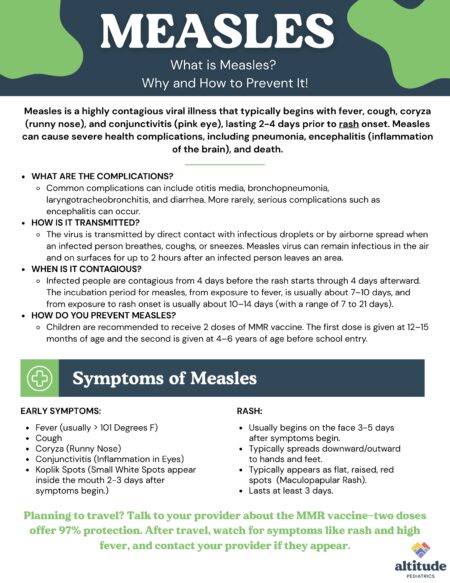
What is Measles?
Measles is a highly contagious viral illness that typically begins with fever, cough, coryza (runny nose), and conjunctivitis (pink eye), lasting 2-4 days prior to rash onset. Measles can cause severe health complications, including pneumonia, encephalitis (inflammation of the brain), and death.
What are the complications?
- Common complications can include otitis media, bronchopneumonia, laryngotracheobronchitis, and diarrhea. More rarely, serious complications such as encephalitis can occur.
How is it transmitted?
- The virus is transmitted by direct contact with infectious droplets or by airborne spread when an infected person breathes, coughs, or sneezes. Measles virus can remain infectious in the air and on surfaces for up to 2 hours after an infected person leaves an area.
When is it contagious?
- Infected people are contagious from 4 days before the rash starts through 4 days afterward. The incubation period for measles, from exposure to fever, is usually about 7–10 days, and from exposure to rash onset is usually about 10–14 days (with a range of 7 to 21 days).
How do you prevent Measles?
- Children are recommended to receive 2 doses of MMR vaccine. The first dose is given at 12–15 months of age and the second is given at 4–6 years of age before school entry.
- Infants 6 months of age or older can receive MMR prior to international travel or in outbreak settings (see below). MMR is not licensed for children <6 months of age.
- Adults not at high risk of exposure are recommended to have at least 1 documented dose of MMR in their lifetime, or other evidence of immunity (e.g., positive measles immunoglobulin G (IgG)). Adults at high exposure risk, including students at post-secondary institutions, healthcare workers, and international travelers, should have two documented doses.
Symptoms of Measles:
Early Symptoms
- Fever (usually > 101 Degrees F)
- Cough
- Coryza (Runny Nose)
- Conjunctivitis (Inflammation in Eyes)
- Koplik Spots (Small White Spots appear inside the mouth 2-3 days after symptoms begin.)
Measles Rash
- Usually begins on the face 3-5 days after symptoms begin.
- Typically spreads downward/outward to hands and feet.
- Typically appears as flat, raised, red spots (Maculopapular Rash).
- Lasts at least 3 days.
The rash usually appears about 14 days after a person is exposed and spreads from the head to the trunk to the lower extremities. Patients are considered to be contagious from four days before to four days after the rash appears.
Recommendations for Domestic Travelers to Outbreak Areas and International Travelers
Talk to your doctor about the MMR vaccine, especially if you or your child plan to travel to an area with an ongoing outbreak or internationally. Two doses of MMR vaccine provide better protection (97%) against measles than one dose (93%).
Check your destination and CDC’s Global Measles Travel Health Notice for more travel health advice if you plan to travel internationally, including countries measles outbreaks have been reported.
After domestic travel to an area with an ongoing outbreak or international travel, watch for signs and symptoms of measles for 3 weeks after returning to the United States. If you or your child gets sick with a rash and a high fever, call your healthcare provider. Tell them you traveled to an area where they identified measles or another country and whether you or your child had received MMR vaccine.